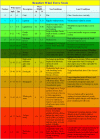D
Deleted member 114292
Guest
FWIW With my MP2 I would fly on this day. At least up until 19:00 hours.We've all heard about fly-aways and other incidents because of ignoring conditions. I know how to do the math, but don't have much practical experience flying yet. I've been very conservative when it comes to wind conditions, perhaps overcautious, causing me not to fly on days when I might have. I live about 3 miles from Lake Michigan, which has a few good scenic opportunities.
I have a Mini and a M2 Pro, the latter of which I bought because I thought the wind gusts kept me out of the air too many days. But now with the M2, I feel like I may still be too overcautious of the conditions. I need some common sense imparted from you more experienced guys. It may be important to know that right now I don't fly very far, I think 3600 feet has been my distance threshhold and am not ready to test range. I guess I need a shot of encouragement and common sense to help me understand when it's safe to fly and when it become "iffy".
I'm attaching a screen shot of today's conditions.... Would you go flying today? Times to avoid, if any?
View attachment 112584
To be honest I really don't like flying in higher winds.
If you want to be a great drone pilot practice maneuvers instead of just flying around.
Learn to fly smooth circles, figure 8's, V's and W's etc. All in a safe contexts.
Great pilots are NOT test pilots and there is no need to push any limits, other that that of your skills by perfecting your maneuvers.












